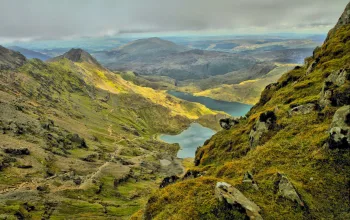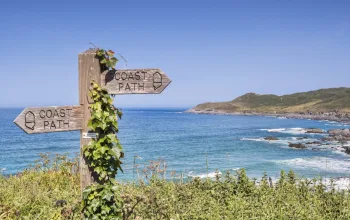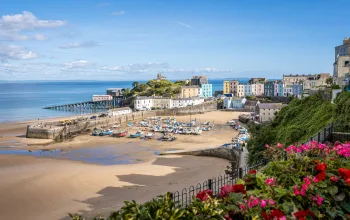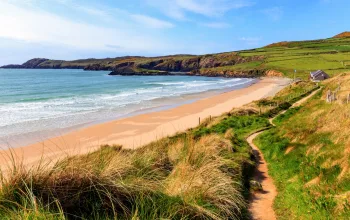The car park at Start Point must be a contender for one of the best views of any car park in the UK, with views back across to Beesands and the ruins at Hallsands to your left, and down to the lighthouse to your right. The walk down to the lighthouse is like walking over the spiny tail of some gargantuan prehistoric beast, and indeed the name 'start' derives from the Anglo-Saxon term 'steort' meaning 'tail'. The dramatic gothic-style lighthouse was built back in 1836 on what is one of the most rugged and exposed peninsulas in the UK, running almost a mile into the sea. Designed by James Walker (who designed 29 lighthouses including the Needles, Wolf Rock and Bishop Rock), the contractor Hugh McIntosh was actually blind, but this didn't stop him supervising the build of this impressive structure.
It's definitely worth taking the 45 minute tour to discover the fascinating history of what is the only working lighthouse open to the public in Devon. It was the first lighthouse in the UK to be fitted with Alan Stevenson's revolutionary dioptric apparatus, a refractive lens using prisms rather than the traditional silver mirrors. Incredibly the system works so well that the beam of light slicing through the darkness only uses a 1000 watt bulb. Before electrification, oil burners would have used herring oil, sperm whale oil, seal oil and rape seed oil to power the light. An eerie sounding bell was introduced in the 1860s for use in heavy fog, followed in 1876 by an equally unnerving fog horn that can be heard as far away as Salcombe.
With all this equipment, three lighthouse keepers and their families were based at Start Point, in dwellings that can now be rented as holiday accommodation. They were as self-sufficient as possible, with vegetable gardens, a pigsty and chicken coops. A steep path led down the cliff to a beach where they were able to launch a fishing boat, while they would also catch rabbits and collect seagull eggs. The lighthouse was automated in 1993.
Continuing over the dragon's back, the path takes a dramatic turn as it winds its way around the vertiginous contours of the coast, dropping right down to exposed cliff edges with sharp drops to rocky bays and gullies below. This wild exposed section of the walk is truly spectacular, and on a clear day you can see the horse head shape of the natural arch at Prawle Point in the distance. This is another extremely hazardous stretch of coast for ships, and back in 1873 the tea clipper Lalla Rookh struck the rocks here and disgorged all 1,300 tons of cargo. Apparently the tea formed a bank 10 feet high, which was quarried away by the wives of the fisherman living there. It would seem that not only was salt in their blood, but in their tea as well.
As the path drops down closer to the sea at Peartree Point, you can reach a secret shingle beach surrounded by several rocky islands. It's a delightful spot for a dip, although stay close to the coast, as there are some strong currents out near the islands. A natural channel between sea cliffs and the rocky islands guides you out into the azure waters of a lagoon, with the lighthouse standing as a guardian in the distance. Swim off to the left and you'll discover a cave to explore, while there are also several tempting rocks to jump from. The area is also home to a grey seal colony, although don't worry, as they seemed more scared of us when we visited. There are also several underwater arches here, which probably make for a perfect play and hunting ground for these curious mammals.
You get great views over Great Mattiscombe Beach as you walk around the headland. The curious geology makes the spot popular for students, with a raised beach and natural conical pillars resembling the chimneys of a tin mine. The raised beach reflects the sea level millions of years ago. It is covered in glacial debris from the last ice age and the conical pillars are the remains that haven't yet been eroded away. We think the double-layered beach looks a bit like the circle and stalls at a theatre, looking over the striking Great Rock, which seems precariously balanced at low tide when it is fully exposed.
The beach was once known as 'More Rope Bay,' thanks to a rather wretched local legend. When a ship was lured onto the rocks by wreckers looking to plunder the cargo, some more upstanding local villagers attempted to rescue the crew from the rocks where they were stranded. They lowered a rope down the cliffs but it wasn't long enough. The survivors desperately called for more rope as the tide rose around them. The beach at Great Mattiscombe Sands was also used as a filming location in Tim Burton's comedy vampire fantasy, Dark Shadows starring Johnny Depp, albeit with towering CGI cliffs that were added in later.
Set up base on the beach and prepare for some delicious swimming in these sparkling waters. When we arrived a group of lads were making full use of the first rock as a natural diving platform, while we entered the water near the Great Rock and swam off to the right. This area of the beach is popular for bouldering (low level climbing without ropes) and we headed off in the direction of the conical pillars, which one wit in our party compared to Madonna's Jean Paul Gaultier bra. It was mid-tide and we passed plenty of rocks to conquer and jump from, before swimming through a natural maze of channels and then back towards the dark golden sands, to bake dry in the sunshine.
It's a much shorter walk back up to the car park through some beautiful fields. Keepaneye out for some colourful butterflies including green hairstreaks and clouded yellows, while in the spring and summer you may be fortunate to spot a cirl bunting, as well as ravens and buzzards hovering on the air currents above potential prey. We combined this swim walk with a night camping in Sally Tripp's field at East Prawle, with stunning views down to the sea. It was then off for a few ales in the legendary Pigs Nose Inn, where we reminisced about the day's adventurers, before a final warming nightcap at the campsite under a magnificent blanket of stars.
Start Point wild swimming walk, Devon directions
1 The walk begins in the pay car park at Start Point, which is worth every penny for the incredible views alone. Head out through the gate or over the stile and follow the Coast Path down the old lighthouse road towards the sea, until you reach the lighthouse. 0.6 miles
2 After visiting the lighthouse, continue to follow the coast path west along the cliffs until you reach the small headland of Peartree Point. Here you can climb down to the secret shingle beach and swim spot. Do stay close to the coast when swimming as there are some strong currents further out near the larger rocky islands. 0.7 miles
3 From Peartree Point, continue to the west along the coast path to Great Mattiscombe Sand, walking down the steps to the beach. 0.3 miles
4 Follow the track uphill from the beach and through several gates to return to the car park half a mile away. 0.4 miles
Route reproduced with kind permission from Wild Swimming Walks, book available now for only £14.99 from wildthingspublishing.com






















